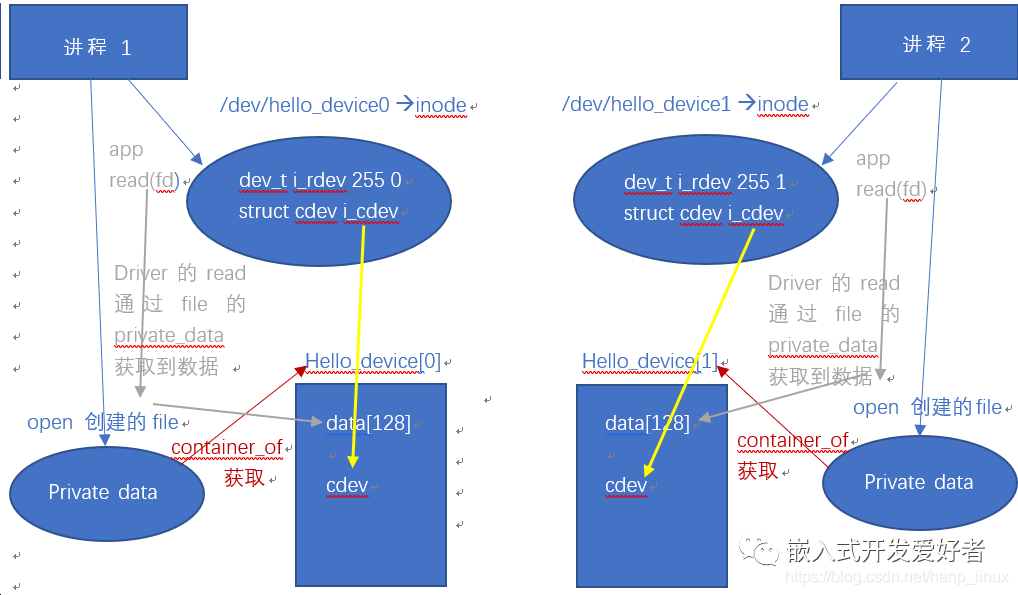

Linux系统中共用一套usb驱动操作案例
嵌入式技术
描述
1. 应用场景
比如我们的设备上有很多一样的usb接口,这些usb接口都需要有驱动才能工作,那么是每个usb都一套单独的驱动程序么?显然不是的,这些usb接口属于同一类设备,用户对他们的操作方法完全一致,只不过不是同一个设备,所以他们可以复用同一套驱动代码,在代码中去判断用户要操作哪个设备,然后去open/read/write这个设备。
2. 如何区分不同的设备
前面说过,每个设备都有一个唯一的标识符–设备号,那么对于同一类设备,它们的主设备号是一样的,次设备号是不一样的,用来区分它们,当用户想要操作哪个具体的设备,就会打开这个设备对应的设备文件(inode结构体),并自动在内核中创建对应的file结构体,这个file结构体中就保存了用户操作的所有信息,最终会传给我们的内核驱动,驱动再根据这个file结构体和inode结构体来判断用户具体要操作的哪个设备,然后去read/write这个具体的设备。
案例:
hanp@hanp:/dev/usb$ ls -l
crw------- 1 root root 180, 0 3月 11 17:29 hiddev0
crw------- 1 root root 180, 1 3月 11 17:29 hiddev1
我的主机下面的两个usb设备,他们共用了一套usb驱动,但是他们的设备号是不一样的(180,0)和(180,1),主设备号都是180表示都属于同一类设备(usb设备),次设备号分别是0和1,表示这是两个不同的设备。
3. 代码实现
int major = 255;
/* 两个设备,所以有两套结构体 */
/* 设备0对应的设备结构体是hello_dev[0], 设备1对应的设备结构体是hello_dev[1] */
struct hello_device {
dev_t devno;
struct cdev cdev;
char data[128];
char name[16];
}hello_dev[NUM_OF_DEVICES];
struct class * hello_class;
const char DEVNAME[] = "hello_device";
int hello_open(struct inode * ip, struct file * fp)
{
printk("%s : %d
", __func__, __LINE__);
/* 获取用户打开的设备对应的设备结构体 hello_dev[0] 或者 hello_dev[1] */
struct hello_device * dev = container_of(ip->i_cdev, struct hello_device, cdev);
/* open的时候,通过container_of能够获取到用户要打开的那个设备的设备结构体,所有需要把这个结构体通过file指针的
* private_data参数传递给read/write */
fp->private_data = dev;
/* 一般用来做初始化设备的操作 */
/* ... */
return 0;
}
int hello_close(struct inode * ip, struct file * fp)
{
printk("%s : %d
", __func__, __LINE__);
/* 一般用来做和open相反的操作,open申请资源,close释放资源 */
/* ... */
return 0;
}
ssize_t hello_read(struct file * fp, char __user * buf, size_t count, loff_t * loff)
{
int ret;
/* 通过file指针,获取到用户要操作的设备对应的设备结构体 */
struct hello_device * dev = fp->private_data;
/* 将用户需要的数据从内核空间copy到用户空间(buf) */
printk("%s : %d
", __func__, __LINE__);
if (count <=0 || count > 128)
count = 128;
if ((ret = copy_to_user(buf, dev->data, count)))
{
printk("copy_to_user err
");
return -1;
}
return count;
}
ssize_t hello_write(struct file * fp, const char __user * buf, size_t count, loff_t * loff)
{
int ret;
struct hello_device * dev = fp->private_data;
/* 将用户需要的数据从内核空间copy到用户空间(buf) */
printk("%s : %d
", __func__, __LINE__);
if (count <=0 || count > 128)
count = 128;
if ((ret = copy_from_user(dev->data, buf, count)))
{
printk("copy_from_user err
");
return -1;
}
return count;
}
/* 2. 分配file_operations结构体 */
struct file_operations hello_fops = {
.owner = THIS_MODULE,
.open = hello_open,
.release = hello_close,
.read = hello_read,
.write = hello_write
};
struct cdev cdev;
static int hello_init(void)
{
int i;
printk("%s : %d
", __func__, __LINE__);
/* 1. 生成并注册两个设备的设备号 */
/* 3. 分配、设置、注册两套cdev结构体 */
for (i = 0; i < NUM_OF_DEVICES; i++)
{
hello_dev[i].devno = MKDEV(major, i);
sprintf(hello_dev[i].name, "%s%d", DEVNAME, i);
register_chrdev_region(hello_dev[i].devno, 1, hello_dev[i].name);
hello_dev[i].cdev.owner = THIS_MODULE;
cdev_add(&hello_dev[i].cdev, hello_dev[i].devno, 1);
cdev_init(&hello_dev[i].cdev, &hello_fops);
/* 初始化两个设备各自的存储空间 */
sprintf(hello_dev[i].data, "Hi, I am hello device %d", i);
}
/* 在/sys/class目录下创建hello类,并在这个类下面创建hello_device0和hello_device1 */
hello_class = class_create(THIS_MODULE, DEVNAME);
for (i = 0; i < NUM_OF_DEVICES; i++)
{
device_create(hello_class, NULL, hello_dev[i].devno, NULL, "%s%d", DEVNAME, i);
printk("success!
");
}
return 0;
}
static void hello_exit(void)
{
int i;
printk("%s : %d
", __func__, __LINE__);
/* 释放资源 */
for (i = 0; i < NUM_OF_DEVICES; i++)
{
device_destroy(hello_class, hello_dev[i].devno);
cdev_del(&hello_dev[i].cdev);
unregister_chrdev_region(hello_dev[i].devno, 1);
}
class_destroy(hello_class);
}
MODULE_LICENSE("GPL");
module_init(hello_init);
module_exit(hello_exit);
解释:
container_of:
/**
* container_of - cast a member of a structure out to the containing structure
* @ptr: the pointer to the member.
* @type: the type of the container struct this is embedded in.
* @member: the name of the member within the struct.
*
*/
#define container_of(ptr, type, member)
功能:根据结构体中某个成员的地址,从而获取到整个结构体的首地址
@ptr: 已知结构体成员的地址
@type: 要获取的结构体的类型
@member: 已知结构体成员的名字
我们用到的实例解析:
struct hello_device * dev = container_of(ip->i_cdev, struct hello_device, cdev);
文章最后的图解和上篇文章中我讲到file结构体和inode结构体的关系,其中inode结构体和文件系统下的文件是一一对应的关系,里面保存了这个字符设备对应的cdev结构体:
struct cdev * i_cdev,而这个cdev结构体又包含在设备结构体hello_device中,其中hello_dev[0]中包含的是设备0的cdev,hello_dev[1]中包含的是设备1的cdev,那么
container_of函数就可以根据这个cdev来判断用户打开的是hello_dev[0]还是hello_dev[1]并获取到地址。

编译安装驱动:
sudo insmod hello.ko
hanp@hanp:/dev$ ls hello_device*
hello_device0 hello_device1
hanp@hanp:/dev$ cat /proc/devices | grep hello
255 hello_device0
255 hello_device1
可以看到在/proc/devices下注册了两个设备hello_device0和hello_device1,这两个设备的主设备一样都是255,但是次设备号不一样(cat /dev/hello_deviceX可以查看次设备号)。
4. 写应用程序进行测试 app.c
int main(char argc, char * argv[])
{
int fd;
int ret;
char buf[64];
if (argc != 2)
{
printf("Usage: %s
" , argv[0]);
return -1;
}
fd = open(argv[1], O_RDWR);
if (fd < 0)
{
perror("fail to open file");
return -1;
}
/* read data */
ret = read(fd, buf, sizeof(buf));
if (ret < 0)
{
printf("read err!");
return -1;
}
printf("buf = %s
", buf);
/* write data */
strcpy(buf, "write data from app!");
ret = write(fd, buf, sizeof(buf));
if (ret < 0)
{
printf("write err!");
return -1;
}
read(fd, buf, sizeof(buf));
printf("buf = %s
", buf);
close(fd);
return 0;
}
测试:
$ gcc app.c
$ sudo ./a.out /dev/hello_device0
buf = Hi, I am hello device 0
buf = write data from app!
$ sudo ./a.out /dev/hello_device1
buf = Hi, I am hello device 1
buf = write data from app!
编辑:黄飞
-
linux系统的设备驱动一般分几类2024-08-30 1363
-
Linux系统中多个同类设备共用一套驱动2023-08-30 1628
-
一套简单的机器视觉系统包括哪些部分?2023-08-20 966
-
altiumdesigner多少钱一套2022-04-07 35504
-
分享一套通用的开发环境搭建教程2021-11-05 1027
-
一套伺服驱动系统2021-09-02 1274
-
如何制作一套波形发生系统?2021-04-21 1174
-
APL库是一套AS功能库与OS操作对象的集合2019-12-05 7060
-
想买一套LINUX的开发板,求大神给推荐。2018-06-20 11490
-
Linux操作系统基本使用知识,Linux操作系统操作流程图文详解2017-11-24 18938
-
一套完全自由的操作系统都有这个秘密2017-09-27 6295
-
CH340驱动(USB串口驱动)_XP_WIN7共用2015-11-17 1461
-
什么是Linux操作系统2009-12-26 1500
-
在Linux中共享Windows系统资源2009-01-18 681
全部0条评论

快来发表一下你的评论吧 !

